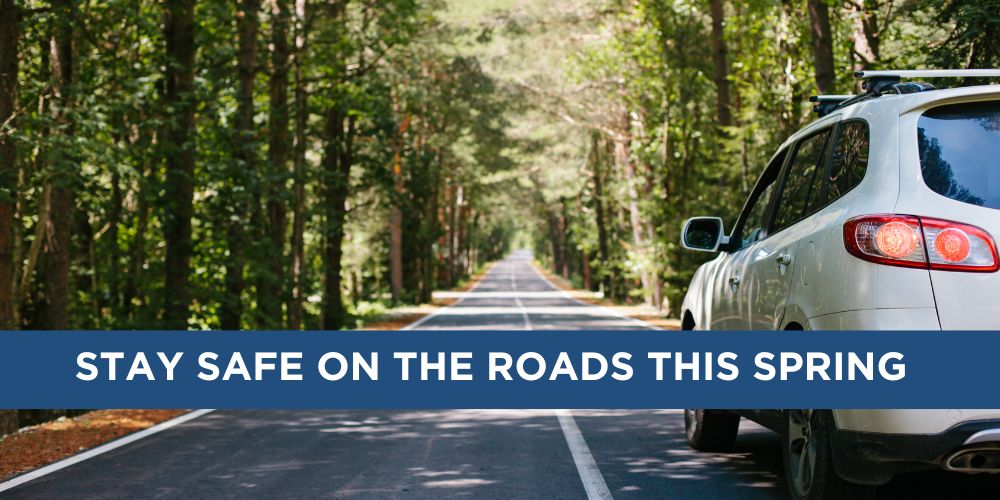

Cuando brotan los capullos de los árboles, las flores se abren paso entre el barro y la nieve y empiezas a estornudar por el polen recién llegado, sabes que ha llegado la primavera.
Pero con la primavera llegan nuevas condiciones a las que prestar atención y nuevas medidas de seguridad con las que estar alerta. Sigue leyendo para saber cómo mantenerte seguro en la carretera cuando se derrite la nieve y empieza a hacer calor.
Adaptarse a las condiciones meteorológicas cambiantes
Por algo se dice "lluvias de abril, flores de mayo". Y si quieres ser más preciso, deberías añadir "barro de marzo" al principio de la lista. El deshielo y el calor reblandecen el suelo y aumentan las probabilidades de que haya barro, lluvia, aguanieve y escombros en la carretera.
Además, la variedad de condiciones meteorológicas en primavera le mantendrá alerta. Esté atento a nevadas, tormentas, chubascos y cualquier otra cosa que pueda imaginar. Un tiempo inusual puede provocar cambios repentinos en el estado de las carreteras, así que tenga cuidado con la velocidad, conduzca según las condiciones de la carretera y tómese su tiempo.
>> ¿Cómo conducir con seguridad cuando nieva?
Asegúrese de que su coche está listo para la primavera
Antes de que empezara el invierno, revisaste tu coche para asegurarte de que no sufrirías una avería en la nieve. Pensaste en neumáticos nuevos o incluso de nieve, pusiste un kit de emergencia en el maletero e hiciste revisar tu coche. Ahora que vuelve a cambiar el tiempo, es el momento de hacer otra revisión.
Llevar al día el mantenimiento periódico del vehículo es siempre la mejor manera de asegurarse de que su coche está preparado para cualquier condición. Pero, además, prepárate, ya que los conductores pueden ser más atrevidos en la calle con las condiciones más cálidas y los peatones pueden andar con más frecuencia.
>> 5 peligros para la seguridad de los vehículos de motor que quizá desconozca
Peligros de la conducción en primavera
En primavera, las carreteras son simplemente diferentes a las que has estado enfrentándote durante los últimos meses. Investiga los problemas de la nueva estación para estar preparado y ponerte en la situación más segura posible antes de ponerte al volante.
1. ¿Cuál es la forma más segura de evitar los baches?


Evitar los baches no es tan sencillo como conducir a su alrededor. A veces, evitarlos puede suponer invadir el carril contrario y, otras, pasar por ellos puede dañar el vehículo. Entonces, ¿cómo hay que actuar?
En primer lugar, cuando revises tu coche esta primavera, asegúrate de revisar los neumáticos y la suspensión, baches son mucho menos problemáticos con un coche preparado para ellos. En segundo lugar, reduce la velocidad cuando veas que se acerca un bache. Por último, comprueba la seguridad de la situación antes de dar un volantazo alrededor de un bache, si hay un coche en el otro carril, no es seguro. Además, ten en cuenta que los baches pueden llenarse de agua y parecer charcos, así que ten cuidado también al conducir por charcos.
2. ¿Cómo evitar el hidroplaneo?


Pavimento mojado provoca 1,2 millones de accidentes de tráfico al año. El hidroplaneo, que se produce cuando los neumáticos del coche pierden tracción con la carretera y se deslizan sobre el agua, es una de las principales causas de accidentes. Para evitar el hidroplaneo hay que asegurarse de mantener la tracción con la carretera. Aquí tienes un par de consejos rápidos para asegurarte de que lo haces:
A. No pongas el control de crucero cuando esté mojado o llueva: asegúrate de que eres tú quien controla el movimiento del coche en esos momentos.
B. Reduzca la velocidad y deje espacio para no chocar con otro vehículo.
C. Finalmente, manejar correctamente un patínConduce en la dirección que el coche quiere ir, suelta el acelerador y absolutamente no frenar bruscamente o hacer giros bruscos, esto sólo aumentará la pérdida de tracción del coche.
3. Compartir la carretera con peatones y ciclistas


Cuando hace más calor, más gente sale a la calle. Más gente en la calle significa más peatones y ciclistas. Así que, cuando conduzcas esta primavera, recuerda vigilar los pasos de peatones, prestar atención a las aceras y los bordes de la calzada, dejar espacio a los ciclistas y, en general, prestar atención a las personas con las que compartes la carretera.
4. Evite los animales en la carretera


En invierno, los animales se esconden e hibernan para evitar las inclemencias del tiempo. Pero cuando llega la primavera, animales salvajes como los ciervos vuelven a los bosques y, potencialmente, a las carreteras. Cada año Sólo con ciervos se producen 1,5 millones de accidentes de tráficopor lo que es importante mantener la vigilancia.
Las horas cercanas al amanecer y al anochecer son las más activas, y los animales se sienten atraídos por la comida, así que no tires nada por la ventana. Ten cuidado también con las zonas por las que pasa un arroyo o curso de agua bajo la carretera, los animales pueden buscar cruzar cerca.
¿Qué otras condiciones primaverales afectan a su conducción?
Ya tienes el coche en buen estado, sabes conducir con seguridad cuando hace mal tiempo y en el agua, eres paciente con los peatones, los ciclistas y los animales. Pero la primavera también trae otros imprevistos.
Los árboles, la hierba y la maleza vuelven a crecer. Pero eso significa polen. Si padece alguna alergia primaveral, incluido el polen, sabrá que le lloran los ojos, estornuda y tose y, en general, no se encuentra bien. Pero eso no afecta a su necesidad de conducir. Entonces, ¿qué debe hacer para mantenerse a salvo de las alergias al volante?
Tomar medicamentos sin receta pueden ayudar a reducir los síntomas, pero asegúrate de leerlos y de que no te produzcan somnolencia al volante. Limpia tu coche en primavera y cambia los filtros de aire: hacer de tu coche un entorno mejor sólo puede ayudarte a lidiar con las frustraciones de la temporada de alergias. Por último, aísla tu coche manteniendo las ventanillas subidas: utiliza el aire acondicionado en lugar de abrir las ventanillas y pon el modo de aire circulante, ya que quieres que entre menos aire del exterior del coche.
¿Cómo se conduce con niebla?
Precipitaciones y cambios meteorológicos puede provocar niebla. Tomarse su tiempo y no dejarse llevar por el pánico contribuye en gran medida a su seguridad. Enciende los faros para que te vean los demás conductores, pero no las luces largas, que deslumbran. Si conduces con niebla espesa, fíjate en las líneas del centro y de los laterales de la carretera para asegurarte de que te mantienes en tu carril.
Si la niebla es impracticable, encienda las luces de emergencia y salga de la carretera hacia un lugar seguro. Espere a que mejoren las condiciones antes de continuar. Si no hay un lugar seguro, sal de la carretera y aparca. Mantén las luces de emergencia encendidas pero apaga los faros. Quita el pie del freno y pon el freno de emergencia para que nadie te atropelle accidentalmente siguiendo tus luces de freno.
¿Cómo conducir con el resplandor del sol?
Con el cambio de las horas de luzLa posición del sol es diferente durante los trayectos matutinos y vespertinos. Esto puede significar una mirada desagradableY aparte de reducir la velocidad y dejar espacio entre los coches, ¿qué se puede hacer?
Prueba a ajustar la hora de ir al trabajo para ver si hay una más segura que se adapte a tu horario. Si eso no funciona, cómprate unas gafas de sol polarizadas para conducir. La otra forma de hacer que la vista sea más tolerable es limpiar el parabrisas. Un parabrisas sucio deslumbra aún más.
>> 5 pasos a seguir tras golpearse la cabeza
Si la conducción de primavera conduce a un accidente, Keches Law está aquí
No importa cuánta preparación hagas, accidentes todavía ocurren. Es bueno saber que tienes un lugar al que acudir si necesitas un abogado después de una primavera accidente de tráfico.
Contacte con el experto abogados de lesiones personales en Keches Law si necesita un abogado, estamos preparados para escuchar su historia y proporcionarle el apoyo y la orientación legal que necesita.




